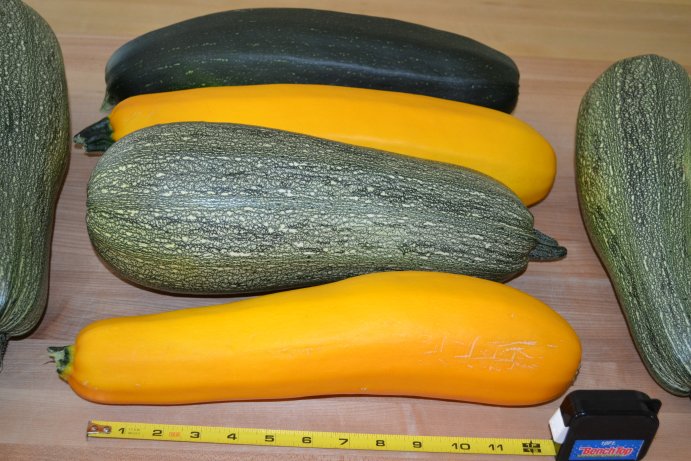In April, I planted several sunflower starts in our backyard in hopes that by August we would have tall, beautifully blooming sunflowers that eventually would yield sunflower seeds. One of these sunflower plants started out as the smallest, and for a while, I was concerned that it might not make it. Eventually, the plant got stronger as it grew, 4 feet then 6 feet, 12 feet, wow – I was amazed at this point, then 14 feet where it stopped growing upward and began to produce a future sunflower bloom (botanically called an infloresence, which is a cluster of individual flowers). We waited excitedly, checked on the plant regularly, and then one morning, the petals began to retract to show a stunning bright yellow sunflower.
Here is the opening:

It took several days for the sunflower to fully open and then the seeds within the bloom began to grow larger, and in the process, increased the size of the bloom.
Here is the full opening:
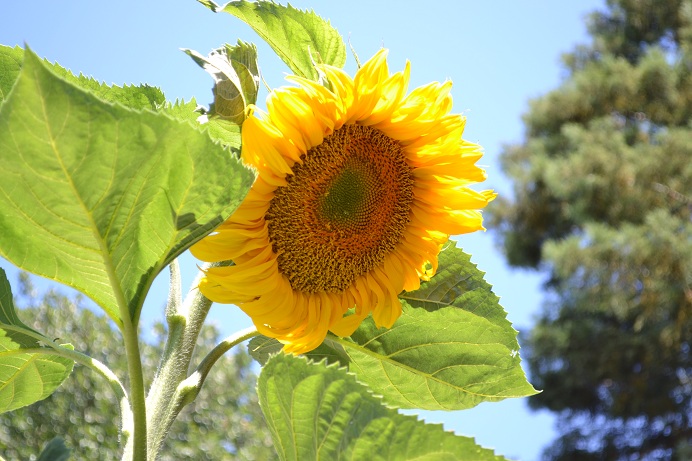
Here is a close up of the seeds:

Each little seed has a flower at the tip that must be individually pollinated for the seed to fully mature. Later this season, we will harvest the seeds and save some for next year, or maybe grow some sunflower sprouts. Once in a while, we enjoy having shelled sunflower seeds in recipes or just by themselves.
Here is a short nutrient analysis of sunflower seeds:
| Nutrient | Shelled sunflower seeds - ¼ cup, 35 g | Adult Daily Values |
| Calories | 204.4 | |
| Protein | 7.27 g | |
| Thiamin (Vitamin B1) | 0.52 | 1.1 – 1.2 mg |
| Riboflavin (Vitamin B2) | 0.12 | 1.1 – 1.3 mg |
| Niacin (Vitamin B3) | 2.92 | 14 – 16 mg |
| Calcium | 27.3 | 1000 – 1200 mg |
| Iron | 1.84 | 8 – 18 mg |
| Magnesium | 113.8 | 310 – 420 mg |
| Potassium | 225.8 | 4700 mg |
| Zinc | 1.75 | 8 – 11 mg |
| Selenium | 18.55 | 55 mcg |
I am always looking for plant-based sources of selenium, and was pleased to find that sunflower seeds are a notable source. The richest plant source of selenium that I have found so far is Brazil nuts. Here is an article that I wrote that shows the selenium content of Brazil nuts.
One of the best ways to keep in touch with us is to join our email list. You’ll receive a free copy of Our Top 12 Strategies for Long Term Success on A Raw Plant-Based Diet eBook along with regular information about raw food and plant-based diets and periodic promotions for our classes, events, and other offerings!
My post-workout berry green smoothie
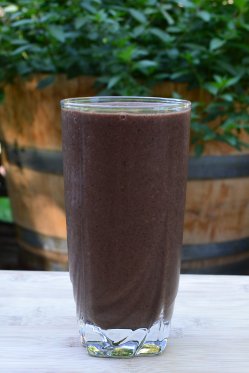 Rick and I have a very active lifestyle and enjoy having a constant amount of energy throughout the day. On days that I exercise, I find that a fruit-containing green smoothie gives me that extra edge, energy-wise. Here is a recipe for one of my favorite post-workout green smoothies:
Rick and I have a very active lifestyle and enjoy having a constant amount of energy throughout the day. On days that I exercise, I find that a fruit-containing green smoothie gives me that extra edge, energy-wise. Here is a recipe for one of my favorite post-workout green smoothies:
2 medium bananas
1 cup orange juice (juice of 3 oranges)
3 cups chopped collard greens (6 medium tree collard leaves)
½ cup fresh raspberries
½ cup fresh blueberries
Here are some of the nutrients found in this smoothie:
| Green smoothie | Adult Daily Values | |
| Calories | 421 | |
| Protein | 8.00 g | |
| Calcium | 210.1 | 1000 – 1200 mg |
| Iron | 1.70 | 8 – 18 mg |
| Zinc | 0.74 | 8 – 11 mg |
| Magnesium | 105.2 | 310 – 420 mg |
| Potassium | 1580.4 | 4700 mg |
| Beta carotene | 4316.2 mcg | |
| Vitamin C | 201.8 | 75 – 90 mg |
| Vitamin E | 3.20 | 15 mg |
| Vitamin B1 | 0.38 | 1.1 – 1.2 mg |
| Vitamin B2 | 0.42 | 1.1 – 1.3 mg |
| Vitamin B3 | 3.67 | 14 – 16 mg |
| Vitamin B5 | 1.64 | 5 mg |
| Vitamin B6 | 1.18 | 1.3 – 1.7 mg |
| Folate | 305.3 | 400 mcg |
The nutrient content of this smoothie is notable and after running four miles today, this smoothie was a welcome treat.
Here is how I made this smoothie:
First, I squeezed the juice from three oranges, peeled two ripe bananas, and gathered and rinsed 6 medium-sized leaves from our tree collard plants. I placed the juice, bananas, and collard greens into our blender:
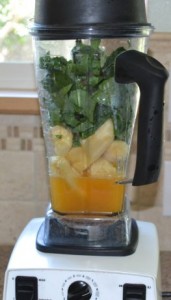
I blended the ingredients until smooth and added the rinsed blueberries and raspberries:
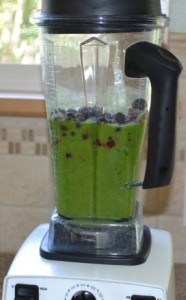
Once again, I blended the mixture until smooth and enjoyed my smoothie.

The blueberries and raspberries give this green smoothie a lovely purple-brown color. 🙂
One of the best ways to keep in touch with us is to join our email list. You’ll receive a free copy of Our Top 12 Strategies for Long Term Success on A Raw Plant-Based Diet eBook along with regular information about raw food and plant-based diets and periodic promotions for our classes, events, and other offerings!
Chocolate mint banana ice cream and nutrient analysis of peppermint
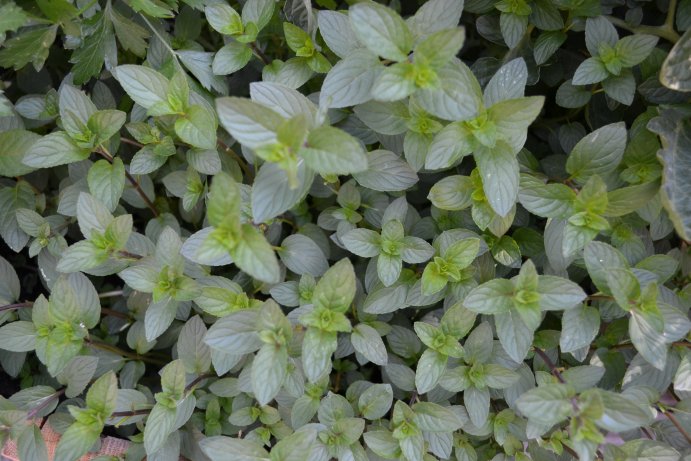
Chocolate, did someone say chocolate?! Yes, chocolate mint, which is one of the many types of mint that one can find in their search for mint plants. In my journeys to various nurseries and plant sales, I have seen the obvious peppermint and spearmint, along with other more exotic types of mint including chocolate mint, and so many more.
I personally love chocolate mint – the fragrance stays true to its name and the flavor to me has a mild peppermint flavor. I currently have chocolate mint and several other types of mint growing in a planter on our deck and find myself enjoying the fragrance of the mint plants whenever I venture into our backyard garden. I have yet to find information on the nutrient content of chocolate mint, so here is a nutrient analysis of its close relative, peppermint, which contains small amounts of important nutrients:
| Fresh peppermint leaves, 10 | Adult Daily Values | |
| Calories | 0.35 | |
| Calcium | 1.22 | 1000 – 1200 mg |
| Magnesium | 0.40 | 310 – 420 mg |
| Potassium | 2.85 | 4700 mg |
I know, nutrient-wise peppermint is rather unremarkable, but Rick and I have found it can really add some zing to frozen recipes especially on hot summer days like today.
Speaking of frozen recipes, I was recently inspired by the fragrance and taste of chocolate mint to create a fun and simple recipe that Rick loves:
Chocolate mint banana ice cream (1 – 2 servings)
3 peeled frozen bananas
10 medium leaves of chocolate mint
There are many ways that Rick and I have made this ice cream. We have used a food processor, high powered blender, and twin-gear juicer. Today, I used the food processor. First, I gathered 10 leaves of chocolate mint from the garden, and then cut 3 frozen bananas into pieces about this size:
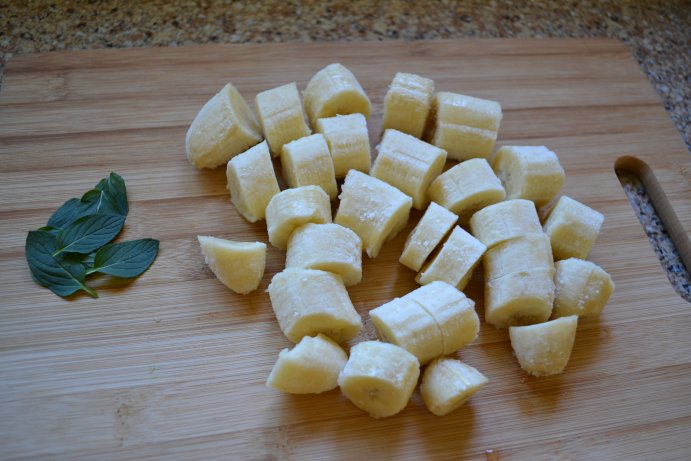
Next, I placed the banana pieces and the chocolate mint leaves into the food processor and placed the lid on the container. I blended the bananas and chocolate mint leaves using short pulses until the mixture became more homogenous:
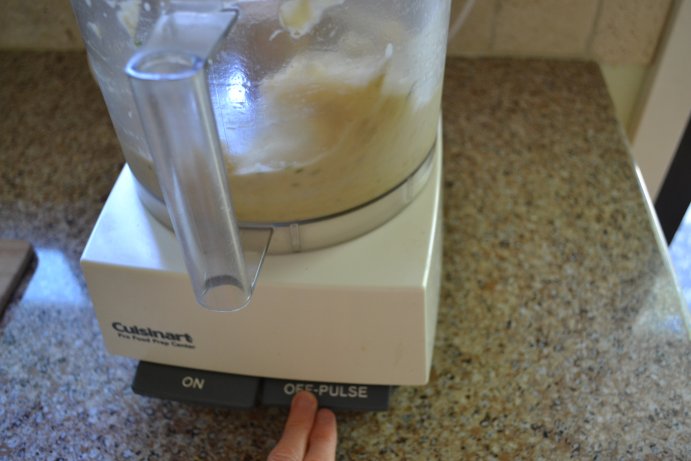
I then blended the mixture continuously until smooth:
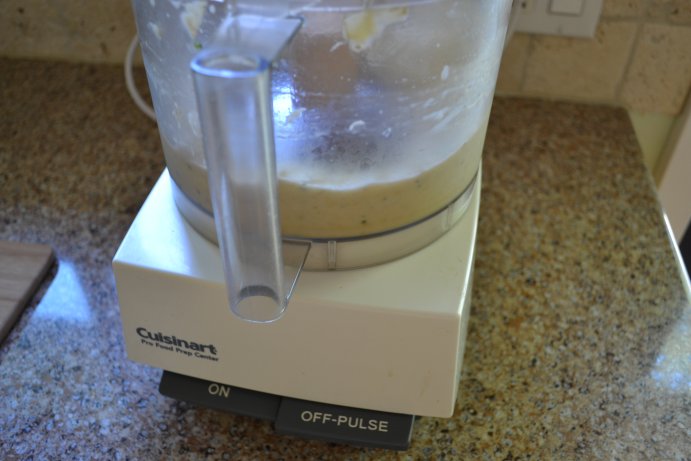
I then scooped the mixture into a serving bowl and placed into the freezer for about 5 minutes to let the mixture freeze. Today was a really hot day, so the mixture was a little runny after blending. Freezing for a few minutes after blending keeps the ice cream from melting before serving. When Rick and I were ready to eat the ice cream, we removed the mixture from the freezer and served with a chocolate mint garnish:
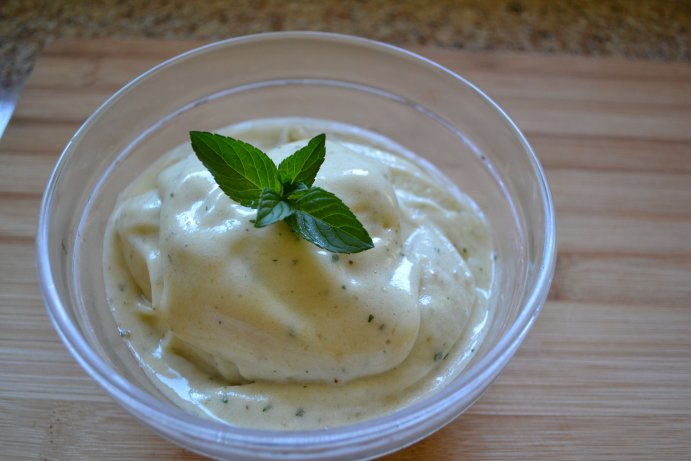
This recipe makes one medium serving or two small servings. Of course, one can make more or less depending on how much one would like to have – Rick likes to eat a lot more than this! 🙂
One of the best ways to keep in touch with us is to join our email list. You’ll receive a free copy of Our Top 12 Strategies for Long Term Success on A Raw Plant-Based Diet eBook along with regular information about raw food and plant-based diets and periodic promotions for our classes, events, and other offerings!
Front yard citrus and a recipe for green lemonade with nutrient analysis
 Whew, what a sense of accomplishment! Rick and I spent a large part of this weekend working on a front yard garden project – planting lemon bushes and a lime tree! We have wanted to do this project for so long, and finally took some time out of our very busy work schedule to do some landscaping that yields these two of our favorite fruits.
Whew, what a sense of accomplishment! Rick and I spent a large part of this weekend working on a front yard garden project – planting lemon bushes and a lime tree! We have wanted to do this project for so long, and finally took some time out of our very busy work schedule to do some landscaping that yields these two of our favorite fruits.
When we moved into our house, our front yard had numerous rose bushes with lovely flowers. After a period of time, we noticed that the blooms started to disappear. I would notice rosebuds on the verge of opening on one day, only to find the bud gone the next. Puzzling – why would a rosebud disappear? This occurrence became increasingly frequent, to the point where it was rare to see flowers or buds on our front yard rose bushes. We had a hunch about what was happening to our roses, but it wasn’t until one morning when I woke up for no particular reason around 4 am. I looked out one of our front windows to find a large deer feasting on our rose bushes! Just as we suspected, which hardly surprised us, given that we live near open space.
We have always loved lemons and limes, so we thought that they would make an attractive addition to our yard and replacement for the roses. About a month ago, we purchased 4 lemon bushes and a lime tree and set aside this past weekend for planting. Since our purchase, the lemon bushes have flowered and have small lemons growing on them! We really like the idea of landscaping that is both attractive and productive. Our neighbors with citrus plants have not had a problem with deer eating them, but we will see what happens. In the meantime, we are excited about the new additions to our yard! To celebrate, here is a recipe for green lemonade (aka my favorite green juice):
8 stalks of celery (12” long)
1 medium lemon, peeled
3 medium cucumber, 8” long
This recipe makes about 48 ounces of juice, depending on the ingredients. Here is a nutrient analysis of the juice ingredients:
| Green lemonade ingredients | Adult Daily Values | |
| Calories | 241.7 | |
| Calcium | 371.1 | 1000 – 1200 mg |
| Iron | 4.1 | 8 – 18 mg |
| Zinc | 2.5 | 8 – 11 mg |
| Magnesium | 180.4 | 310 – 420 mg |
| Potassium | 2774.5 | 4700 mg |
| Vitamin C | 85.7 | 70 – 90 mg |
| Vitamin B1 (Thiamin) | 0.38 | 1.1 – 1.2 mg |
| Vitamin B2 (Riboflavin) | 0.61 | 1.1 – 1.3 mg |
| Vitamin B3 (Niacin) | 2.61 | 14 – 16 mg |
| Folate | 256.8 | 400 mcg |
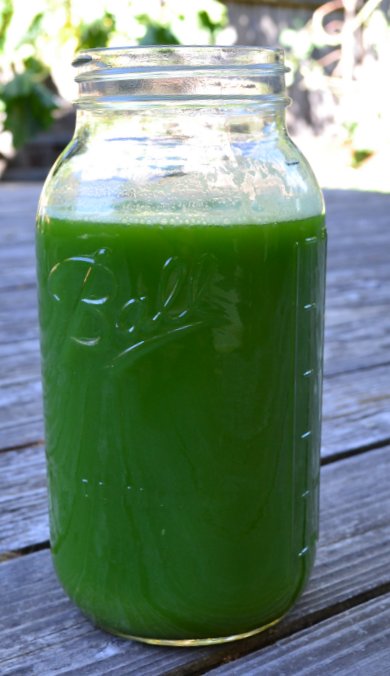
One of the best ways to keep in touch with us is to join our email list. You’ll receive a free copy of Our Top 12 Strategies for Long Term Success on A Raw Plant-Based Diet eBook along with regular information about raw food and plant-based diets and periodic promotions for our classes, events, and other offerings!
Five Things One Can Do With Summer Squash
This week, Rick and I returned home from teaching out of town to find that many our small, six-inch long zucchini squash had grown to over a foot long! There was quite a bit of heat in our area while we were gone, so we weren’t too surprised, but now we are left with a dilemma – what to do with so many huge summer squash. Here are five ideas:
1. Shred into salad – Simple and one of our all-time favorite ways to enjoy summer squash. Rick especially loves summer squash in his salad.

2. Use in dressing – Summer squash is a great ingredient to help add volume to a salad dressing. For example, we use summer squash to increase the volume of our miso-tahini-lemon dressing which is a great strategy to decrease the fat content per volume of a higher fat dressing.
- Our recipe: Juice of ½ lemon, 2 tablespoons tahini (we like raw tahini), ½ teaspoon chickpea miso, 2 cups chopped summer squash. Blend in blender until smooth.
3. Make spiralized summer squash pasta – Have a pasta party! Here is a blog post with recipes for squash pasta and sauce.
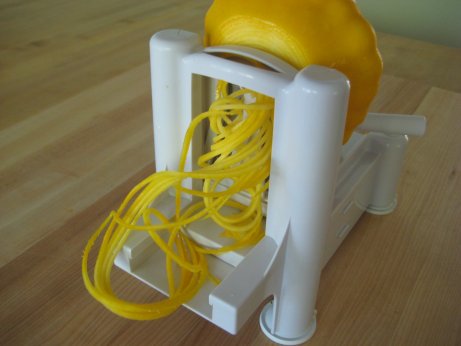
4. Steam them – This helps to soften the toughness of large summer squash skin. We enjoy steaming large summer squash and adding some avocado for consistency and flavor. This recipe reminds me of the steamed summer squash mom used to make when I was young.
5. Share the wealth – We are now in the process of trying 🙂 to share our squash with neighbors and friends. Resoundingly, they have said “hey, thanks for the month supply” (smile) and asked “how can we prepare these?” See 1 – 4 for ideas.
Nutrient analysis of summer squash – all varieties:
| Summer squash – 2 cups chopped (226 g) | Adult Daily Values | |
| Beta carotene | 271 mcg | |
| Vitamin B1 (Thiamin) | 0.11 | 1.1 – 1.2 mg |
| Vitamin B2 (Riboflavin) | 0.32 | 1.1 – 1.3 mg |
| Vitamin B3 (Niacin) | 1.10 | 14 – 16 mg |
| Folate | 65.5 | 400 mcg |
| Calcium | 33.9 | 1,000 – 1,200 mg |
| Magnesium | 38.4 | 310 – 420 mg |
| Potassium | 592.1 | 4,700 mg |
Summer squash may not be a nutrient powerhouse, but it certainly can provide contributory amounts of certain key nutrients, such as the B vitamins listed on the chart above, calcium, magnesium, and potassium.
One of the best ways to keep in touch with us is to join our email list. You’ll receive a free copy of Our Top 12 Strategies for Long Term Success on A Raw Plant-Based Diet eBook along with regular information about raw food and plant-based diets and periodic promotions for our classes, events, and other offerings!
Our Summer and Fall 2012 Science of Raw Food Nutrition I Tour!
Rick and I returned home from our first Science of Raw Food Nutrition I on the road class yesterday to find 1 foot-long zucchinis and ripening tomatoes in our garden! Summer is here in northern California and our summer 2012 tour is in full swing. Our next Science of Raw Food Nutrition I on the road classes are scheduled for Portland, OR and Seattle, WA in September and Fairfield, CT in October.
Our Science of Raw Food Nutrition I on the road class is the same class that we teach in northern California in a slightly different format. It is a 12-hour course covering hot topics including plant sources of iron, calcium, protein, vitamin B12, essential fatty acids, blood sugar, pH balance, food changes from cooking, anti-inflammatory nutrition, weight management, anti-aging and longevity, and much more! Science of Raw Food Nutrition I on the Road is composed of 8 hours of in-class instruction and 4 hours online. For those of you who have wanted to take this class but could not find the time to come to California, here is your opportunity to see us closer to home! We are very happy to bring this class to you!
We will post the final dates and venues for these classes when they are finalized.
One of the best ways to keep in touch with us is to join our email list. You’ll receive a free copy of Our Top 12 Strategies for Long Term Success on A Raw Plant-Based Diet eBook along with regular information about raw food and plant-based diets and periodic promotions for our classes, events, and other offerings!

